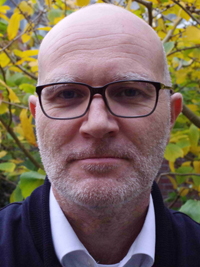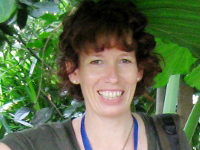Tidlegare gjesteforelesninger og seminarer - Side 40
I will give a series of talks about Legendrian contact homology, an invariant of Legendrian submanifolds in 1-jet spaces, defined by a count of pseudo-holomorphic curves. In this first lecture I will give a brief and gentle introduction to symplectic and contact geometry, with focus on Lagrangian and Legendrian submanifolds. No previous knowledge about the subject is needed, except for elementary knowledge about differentiable manifolds.
By Prof. Jinfeng Wang, Chinese Academy of Sciences, Beijing, China.
Henrik Eklund, ITA
By Dr.phil. Christoph Gradmann, Professor at the Department of Community Medicine and Global Health, University of Oslo.
This seminar is a part of the UiO-PRIO collaborative effort Oslo Lectures on Peace and Conflict
Emerging instabilities and bifurcations from deformable fluid interfaces in the inertialess regime
In this talk, I will present two studies regarding the dynamics of droplets in the creeping flow, focusing on the arising instability and bifurcation phenomena. The first work investigates a buoyancy-driven droplet translating in a quiescent environment and the second a particle-encapsulating droplet in shear flow. There-dimensional simulations based on versatile boundary integral methods were employed to explore the intriguing instability and bifurcation phenomena in the inertialess flow. In the first work, a non-modal stability analysis was performed to predict the critical condition of instability; and in the second, a dynamic system approach was adopted to model and characterize the interacting bifurcations.
Elizabeth Gillaspy from the University of Montana at Missoula, USA, will give a talk with title " Finite decomposition rank and strong quasidiagonality for virtually nilpotent groups "
Abstract: In joint work with Caleb Eckhardt and Paul McKenney, we show that the C*-algebras of discrete, finitely generated, virtually nilpotent groups G are strongly quasidiagonal and have finite decomposition rank. Thus, the only remaining step required to show that primitive quotients of such virtually nilpotent groups G are classified by their Elliott invariant is to check that these C*-algebras satisfy the UCT. Our proof of finite decomposition rank relies on a careful analysis of the relationship between primitive ideals of C*(G) and those of C*(N), where N is a finite-index normal subgroup of G. In the case when N is also nilpotent, we obtain a decomposition of C*(G) as a continuous field of twisted crossed products, which enables us to prove finite decomposition rank of C*(G) by analyzing the decomposition rank of the fibers.
Antoine Julien, Universitetet i Nord, will give a talk with title: Rieffel-type projections in higher-dimensional rotation algebras
Abstract: Rieffel first built a non-trivial projection in the rotation algebra by considering a certain C*-module over this algebra, and exploiting the Morita equivalence which it implements. In this talk, I will present how it is possible to extend these ideas to construct explicitly projections in higher-dimensional noncommutative tori. Precisely, our techniques can be applied to the NC tori which are associated with an R^d-flow on a 2d-torus, or equivalently which are given by the crossed product of C(T^d) by Z^d. I will also hint on how this result can be interpreted as constructing Gabor atoms associated with some lattices in the time-frequency space R^{2d}. This is a joint work with Franz Luef (NTNU).
Emil Rivera-Thorsen, Postdoc, ITA
Abstract: Recently, Steve Kaliszewski, Tron Omland, and I have been investigating the following theorem of Pedersen: two actions of a compact abelian group on C*-algebras A and B are outer conjugate if and only if there is an equivariant isomorphism between the crossed products that respects the positions of A and B. We upgraded this to nonabelian groups (using coactions on the crossed products), and then searched for examples showing that the last condition (on the positions of A and B) is necessary. We failed. This lead us to formulate the "Pedersen Rigidity Problem": if the crossed products of A and B are equivariantly isomorphic, are the actions on A and B outer conjugate? We have been finding numerous "no-go theorems", which give various sufficient conditions for Pedersen Rigidity. Quite recently we have done this for ergodic actions of a compact group, assuming that the actions have "full spectrum". In fact, these actions are (not just outer) conjugate if and only if the dual coactions are. I will summarize our progress on the Pedersen Rigidity Problem and outline the proof of the no-go theorem for these compact ergodic full-spectrum actions.
We will have a “mingle” meeting. There will be updates from Kristine and Per on the running of the institute. But fear not, there will also be plenty of time for informal chat and eating of cake. All are welcome to the lobby on the first floor.
Tiago Pereira, ITA
Elisabeth Lundsør (PhDstudent AQUA)
By Prof. Bruce M.S. Campbell, Emeritus Professor of Medieval Economic History at The Queen's University of Belfast, Northern Ireland
Andreas Carlson og Jean Rabault
Nature has invented ingenious aerodynamic design solutions, some of which are critical for plants as wind dispersal of seeds and fruits is coupled to their flight performance. This formulates into an optimization problem for plants: large seed wings can lead to increased lift and more efficient dispersion, but are costly for the tree to build and can more easily be trapped in the canopy. Double winged seeds/fruits separate from their tree when a specific level of dessication is reached, and autorotate as they descend to the ground. This leads to the question: how is the wing curvature of seeds/fruits linked to their flight performance? To answer this, we develop a theoretical model that suggests the existence of an optimal wing curvature that yields maximal lift. To further understand the interplay between the flow and the wing geometry, we perform a synthetic seed adaptation by deploying 3D printing of double winged fruits that we use in flight experiments, where we span the phase space of aerial dynamics by changing the of wing curvature and seed/fruit weight. Experiments confirm that there is a sweet-spot in curvature to maximise the flight time consisted with geometrical measurements from a wide range of seeds in Nature. Our results highlights the importance of not curving too much or too little for helicopter fruits to have an optimal flight performance.
Martin Sahlén, University of Uppsala
Elisabeth Seland
In my job as research adviser, I receive a lot of questions about rights, possibilities and problems in connection with scientific publishing and open access. Both EU and the Norwegian Research Council have rules about this, and there is also a UiO policy in place that is relevant for all employees. I will give a short presentation to try to clear up what you have to, must, may, could and should related to Open access. In my experience many of you have the same questions about these issues, so I hope you bring your questions with you and we can address them in the seminar.
I will discuss the differential structure in the mod 2 Adams spectral sequence for tmf, leading to its E_\infty-term. These calculations were known to Hopkins-Mahowald; in their current guise they are part of joint work with Bruner.
Guest lecture by Professor Dr. Christian Zidorn, Department of Pharmaceutical Biology, Christian-Albrechts-Universität (CAU) Kiel, Germany.
Guest lecture by Professor Dr. Birgit Classen, Department of Pharmaceutical Biology, Christian-Albrechts-Universität (CAU) Kiel, Germany.
by Indrė Žliobaitė, University of Helsinki, Finland


